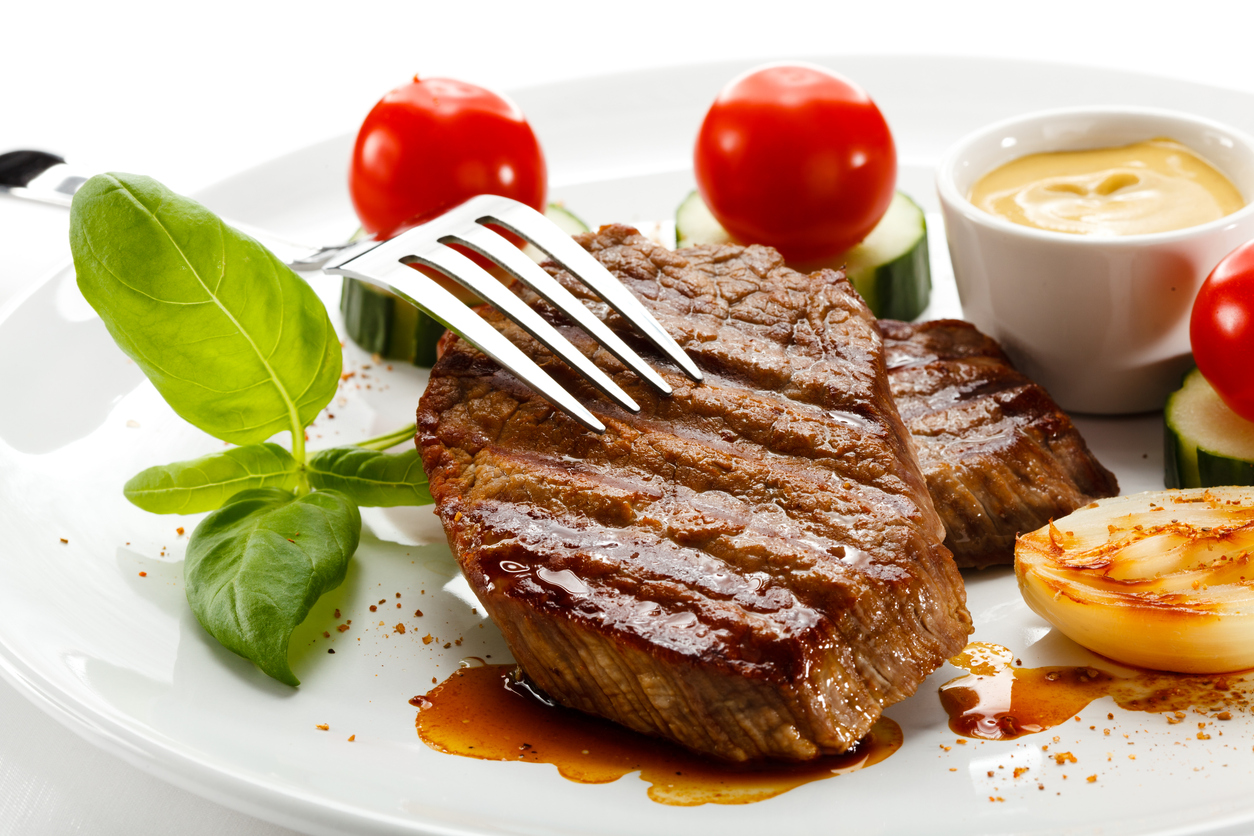There are so many mixed messages out there when it comes to red meat. On the one hand, it’s very much a part our cultural identity with ‘steak and potatoes’ or a ‘hamburger and fries’ being iconic American meals. Yet on the other hand, we hear stories about the evils of beef, including saturated fat, digestion issues, added hormones, and questionable feeding practices. So which is it? Is beef a good or bad thing when it comes to a healthy diet? Our answer is….it depends.
We recognize that beef is not necessarily a requirement for a healthy diet. You can get good quality protein from a number of sources, and vegetarian and vegan diets are viable options for some families. But for those who choose to include beef in their family’s meals, it is really important to consider the source. The animals we ate throughout history roamed free and ate grass, whereas cattle today is often fed grains (soy, corn, etc.) to save money and help fatten them up. The way cows are fed can have a major effect on the nutrient composition of the meat. Therefore, when it comes to beef, it’s not just what you eat…it’s what the cows ate that matters.
Grass-Fed Versus Grain-Fed
The main thing to look for when choosing beef is whether it comes from grass-fed or grain-fed cows. All cows start out living similar lives, until about age 6-12 months. At this point, “conventionally” raised cows are moved to feedlots, which are pretty nasty places where they are rapidly fattened up with grain-based feeds. These feeds are made out of corn and soy, and almost always contain GMOs. In addition, more than 15 million pounds of antibiotics are used on grain-fed cattle annually to make them grow even bigger. Traces of these antibiotics, along with some toxic chemicals like the pesticides and herbicides used on the grains, will be stored in the animal’s fat and could eventually end up on your plate.

Compare that to grass-fed cows that continue to live on grassland, eating their natural diet for the remainder of their lives. Cows are meant to roam and eat grass, a grain diet is unnatural to them and is therefore hard on their digestive system taking a toll on their overall health. This is one of the reasons why grass-fed beef contains 2 to 4 times more omega-3 (essential fatty acids), 4 times more vitamin A and E, and less fat calories per pound that grain-fed beef. Grass-fed beef also contains about twice as much Conjugated Linoleic Acid (CLA) as grain-fed. This fatty acid is associated with reduced body fat and some other beneficial effects. In other words, if you want the healthier choice, it’s worth going the extra mile to find 100% grass-fed beef.
How can you be sure your beef is truly grass-fed? This is an excellent question. It isn’t always easy. The best way is to know the source of your meat, to buy local at a farmers market or a health food store where you can verify the beef farmer’s methods. You want to be sure the cows were grass-fed for their entire lives (i.e are 100% grass-fed).
Some farmers will feed their animals grass for most of their lifespan, but then finish them with grains the last few months to make them bigger before slaughter. The problem with this practice is that it’s the cow’s diet over the last 90-120 days of life that is going to determine the nutrients in the meat. Buying “grain-finished” beef isn’t going to get you the same nutritional content as buying beef that was solely grass-fed. If you can’t know your rancher or beef farmer, then pay special attention to beef package labeling. Here’s what those labels mean:
100% Grass-Fed:
This means the cattle have been allowed to forage and graze for their own fresh food. These cows have only eaten grass throughout their lives.
Grass-Fed:
This may mean the cattle have only eaten grass, but be aware that grain-finished beef can sometimes hide behind this label, so do a little research (or ask your butcher) to make sure that a particular beef farmer sticks to grass only. If you want to be absolutely sure, look for the 100% grass-fed label.
Grass-Finished:
The cattle are fed grass the last few months of their lives. They most likely started on grains, and then were switched over before slaughter.
Grain-Finished:
The cattle are fed grains 90-160 days before slaughter. As noted above, this will decrease the level of nutrients like CLA and omega-3 in the beef.
Organic:
This label doesn’t so much describe how the cattle was raised as list the ways that they can’t be raised. The cows cannot be confined in a feedlot for any extended period of time, cannot be over-crowded or kept in unsanitary conditions, and cannot be directly or indirectly exposed to artificial pesticides, fertilizers, antibiotics, hormones, GMOs, or other synthetic contaminants.
Natural:
When it comes to beef, this label is totally unregulated. Natural beef can be grain fed or live in confinement; the label just means that whatever grain-based feed the cattle were given, it was certified natural. This label means pretty much nothing to you as a consumer.
What’s the difference between 100% grass-fed and organic beef?
We’re glad you asked! There is a lot of overlap between organic and grass-fed beef, because both practices are trying to raise healthier, less chemically-contaminated cows. However, not every pasture-raised cow is USDA Certified Organic, and not every organic cow is fed a 100% grass diet or allowed unlimited access to roam. Confused yet? So were we. It breaks down like this:
Certified Organic beef can be raised on a diet of corn or grain, but they must spend some time outdoors, so a portion of their diet will be grass too. But unless you talk to the rancher directly, it’s impossible to know how much. Certified Organic does guarantee that the beef will be free from artificial contaminants.
Grass fed beef has many of the benefits of organic beef, simply as a side effect of raising the cattle on a pasture. Since the cows are in their natural habitat, with access to all of the open land needed to support a herd of cattle, their lives are less stressful, and more sanitary, which means their immune systems are under less pressure. This results in meat that is much less likely to be contaminated with diseases like E. Coli. If antibiotics are used on grass-fed cattle, it’s only in rare cases to treat illness, not constantly like on feedlots.
While grass-fed, non-organic beef may be exposed to more chemicals than organic, it’s certainly cleaner than conventional beef. Keep in mind that the certified organic label is expensive. A lot of small 100% grass-fed cattle farmers care about quality, and raise their animals under conditions that would be certified as organic, but they can’t afford the record-keeping and inspections it takes to get the label. Just because a grass-fed steak is not Certified Organic doesn’t necessarily mean that it’s of poorer quality.
Beenke’s Take-Aways:
- Know the source of your beef and how the cattle were raised and fed.
- 100% grass-fed beef is the healthiest choice.
- If you can’t find (or afford) beef with both labels, stick to 100% grass-fed. This farming practice will provide many of the benefits of organic by default.
- If you can’t get grass-fed beef, choose the leanest cuts of grain-fed beef you can buy. This reduces the chance of the meat containing toxins that can be stored in the animal’s fat.
What do you think about grass-fed, organic, or conventionally raised beef? Share your comments in our Health Community!












